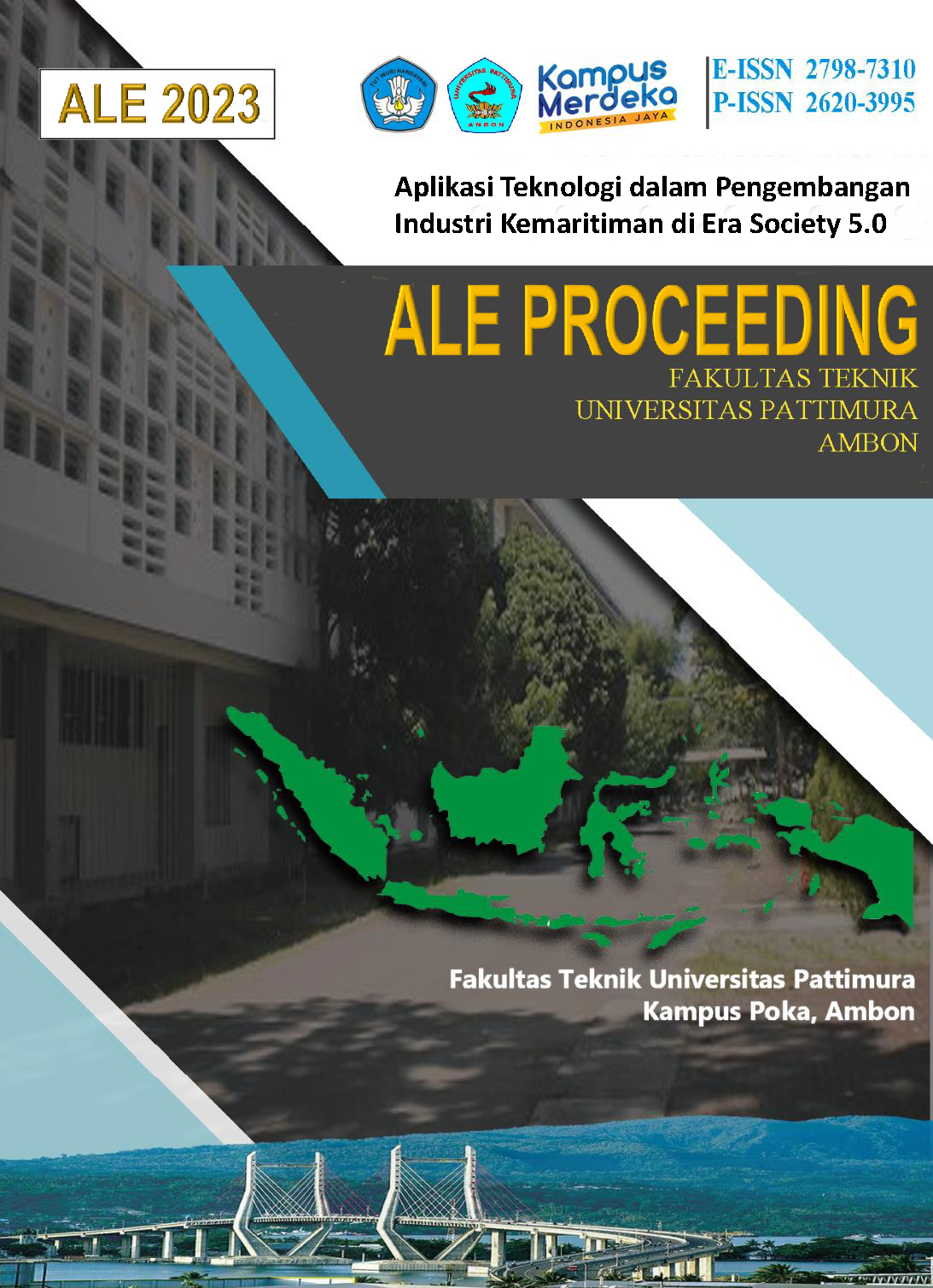IDENTIFIKASI KENDALA-KENDALA KONEKTIVITAS TRANSPORTASI LAUT DI WILAYAH KEPULAUAN
(Studi Kasus Provinsi Maluku)
Abstract
Sistem transportasi geografis berkaitan dengan pergerakan orang, barang dan informasi, yang mencoba mentautkan kendala-kendala dan atribut-atribut spasial dengan titik-titik asal, titik-titik tujuan, jarak, sifat dan tujuan pergerakan. Konektivitas antar pulau menjadi salah satu kendala transportasi geografis untuk pengembangan sistem transportasi laut di wilayah kepulauan. Provinsi Maluku dengan 1.388 pulau dengan infrastruktur transportasi darat terbatas di sebagian besar pulau, mobilitas orang dan barang rendah, memiliki permasalahan konektivitas antar pulau yang cukup rumit. Dengan menggunakan analisis Weighted Arithmetic Mean (WAM) dan analisis statistik diketahui bahwa masalah utama yang dihadapi oleh para pengguna moda transportasi laut di wilayah kepulauan adalah waktu tunggu yang cukup lama di pelabuhan, disamping tidak tersedianya informasi penjadwalan kapal. Ketiadaan kapal pada saat dibutuhkan juga merupakan salah satu masalah utama sistem transportasi antar pulau di wilayah kepulauan
Downloads
References
[2] G. M. Speranza, “Trends in Transportation and Logistics,” Eur. J. Oper. Res., vol. 264, no. 3, hal. 830–836, 2018.
[3] H. I. Nur, T. Achmadi, dan K. Mercy, “Analysis of Seven International Indonesian Hub Ports Policy Development Impact on Shipping and Port Sector,” IOP Conf. Ser. Earth Environ. Sci., vol. 557, no. 1, 2020, doi: 10.1088/1755-1315/557/1/012061.
[4] J. P. Rodrigue, C. Comtois, dan B. Slack, Transportation and The Spatial Structure, 3rd ed. 2013.
[5] M. B. Lekakou dan T. K. Vitsounis, “Market Concentration in Coastal Shipping and Limitations to Island’s Accessibility,” Res. Transp. Bus. Manag., vol. 2, hal. 74–82, 2011, doi: 10.1016/j.rtbm.2011.10.001.
[6] G. Wilmsmeier dan T. Notteboom, “Determinants of Liner Shippping Network Configuration: A Two-Region Comparison,” GeoJournal, vol. 76, no. 3, hal. 213–228, 2011, doi: 10.1007/s10708-009-9333-2.
[7] P. W. de Langen dan K. Sharypova, “Intermodal Connectivity as a Port Performance Indicator,” Res. Transp. Bus. Manag., vol. 8, hal. 97–102, 2013, doi: 10.1016/j.rtbm.2013.06.003.
[8] J. Jiang, L. H. Lee, E. P. Chew, dan C. C. Gan, “Port connectivity study: An analysis framework from a global container liner shipping network perspective,” Transp. Res. Part E Logist. Transp. Rev., vol. 73, hal. 47–64, 2015, doi: 10.1016/j.tre.2014.10.012.
[9] G. Wilmsmeier dan R. J. Sánchez, “Evolution of Shipping Networks: Current Challenges in Emerging Markets,” Z. Wirtschgeogr., vol. 54, no. 3–4, hal. 180–193, 2010.
[10] S. Mishra, F. T. Welch, dan K. M. Jha, “Performance Indicators for Public Transit Connectivity in Multi-Modal Transportation Networks,” Transp. Res. Part A Policy Pract., vol. 46, no. 7, hal. 1066–1085, 2012, doi: 10.1016/j.tra.2012.04.006.
[11] T. F. Welch dan S. Mishra, “A Measure of Equity for Public Transit Connectivity,” J. Transp. Geogr., vol. 33, hal. 29–41, 2013, doi: 10.1016/j.jtrangeo.2013.09.007.
[12] S. Kaplan, D. Popoks, C. G. Prato, dan A. Ceder, “Using Connectivity for Measuring Equity in Transit Provision,” J. Transp. Geogr., vol. 37, hal. 82–92, 2014, doi: 10.1016/j.jtrangeo.2014.04.016.
[13] Y. Hadas, “Assessing Public Transport Systems Connectivity Based on Google Transit Data,” J. Transp. Geogr., vol. 33, hal. 105–116, 2013, doi: 10.1016/j.jtrangeo.2013.09.015.
Copyright (c) 2023 Lodewyk Matheos Kelwulan, Ruth P. Soumokil, Monalisa Manuputty

This work is licensed under a Creative Commons Attribution-ShareAlike 4.0 International License.
An author who publishes in the ALE Proceeding agrees to the following terms:
- Author retains the copyright and grants ALE Proceeding the right of first publication of the work simultaneously licensed under the Creative Commons Attribution-ShareAlike 4.0 License that allows others to share the work with an acknowledgment of the work's authorship and initial publication in this journal.
- Author is able to enter into separate, additional contractual arrangements for the non-exclusive distribution of the journal's published version of the work (e.g., post it to an institutional repository or publish it in a book) with the acknowledgment of its initial publication in this journal.
- Author is permitted and encouraged to post his/her work online (e.g., in institutional repositories or on their website) prior to and during the submission process, as it can lead to productive exchanges, as well as earlier and greater citation of the published work (See The Effect of Open Access).
Read more about the Creative Commons Attribution-ShareAlike 4.0 Licence here: https://creativecommons.org/licenses/by-sa/4.0/.






